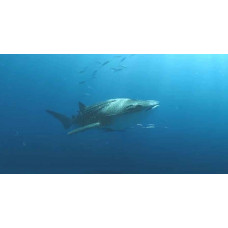Identification
Like all fish, sharks are vertebrates, but ichthyologists separate them from most bony fish because a shark's skeleton consists of cartilage, not bones. Sharks have five to seven gill slits on each side of the head. In contrast, bony fish have one gill slit on each side of the body, closed by a bony plate called an operculum. Sharks also do not have gas-filled swim bladders like most bony fish. Instead, sharks have developed a different way of maintaining buoyancy: They have very much livers that contain fats that are lighter than water. These fats, combined with a cartilaginous skeleton, give sharks almost neutral buoyancy. Not all sharks have to swim constantly to pump water through their gills to breathe. Some may actively pump water through their gills and sometimes lie motionless on the bottom. Many bottom-dwelling sharks pump water through their gills most of the time. However, sharks must literally float or sink because their bodies are slightly denser than water, and they need to move forward to stay afloat. Sharks have several physical adaptations that make them entirely effective swimmers. They have a well-developed visual system that functions well in bright and low light, thanks to a special structure in the eye called tapetum lucidum, which increases sensitivity in low light. At close range, the shark's electroreceptor system comes into play. Receptors located in the pores on a shark's snout and lower jaw are capable to pick up the tiny electric fields created by the muscle movements of the prey. Shark teeth come in many shapes and sizes, just like sharks themselves. They also tell us something about the shark's diet. Some sharks are specialized predators. Their teeth are adapted to effectively capture their preferred prey. Others eat whatever is available, and their teeth are adapted for many types of food. Great whites use their triangular, serrated teeth to grasp and bite off chunks of large fish and marine mammals. Other fish use their flat teeth to crush shells of clams and crustaceans. Other species have narrow, pointed teeth to grasp and hold prey small enough to swallow it whole. Sharks have placoid scales, or prongs, tiny bony protrusions embedded in the shark's skin. They come in many shapes and sizes, but typically completely cover the shark's skin like armor. Their main function is to protect and reduce resistance when the shark's body splits the water. The serrations give the shark's skin a rough texture, like sandpaper.
Size
Some species are estimated to live 40 or 50 years.
Food and feeding habits
The shark swallows food whole or pieces. Once full, the shark may not eat again for several weeks. When food is digested, it passes through the intestine, which has a spiral valve structure unique to sharks. This valve increases the inner surface of the intestine for more efficient absorption of nutrients. Sharks are opportunistic feeders and often eat whatever is available. When sharks swim, they are constantly checking the water for odors and sounds. They can detect odors at several parts per million and are attracted by low-frequency vibrations. Feeding depends on vision and detection of electric fields.
Reproduction
Sharks have several reproductive strategies. Some enclose fertilized eggs in rigid, leathery eggshells that are released into the water for later development and birth. Some females retain the eggs in their bodies and hatch their young inside, so that, they are born alive and fully formed. Others have a complex placental arrangement similar to that found in mammals. Many sharks take 10 to 20 years to reach sexual maturity, and they do not produce more than one calf at a time.
| Classification | |
| Phylum | Chordata |
| Class | Chondrichthyes |
| Features | |
| Habitat | Pelagic |
| Life span, years | 100 |
| Maximum body weight, kg | No information |
| Maximum length, cm | 2000 |
| Sailing speed, m/s | 13.9 |
| Threat to people | Edible |
| Way of eating | Predator |
Sharks
Tags: Sharks







